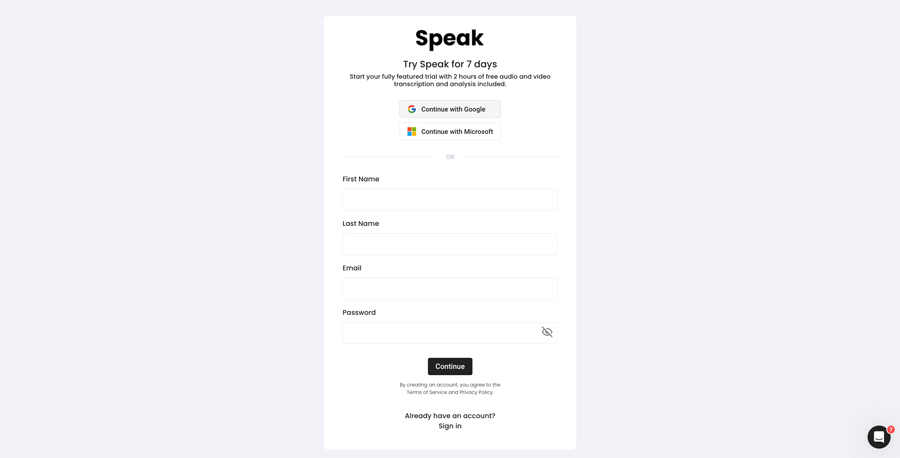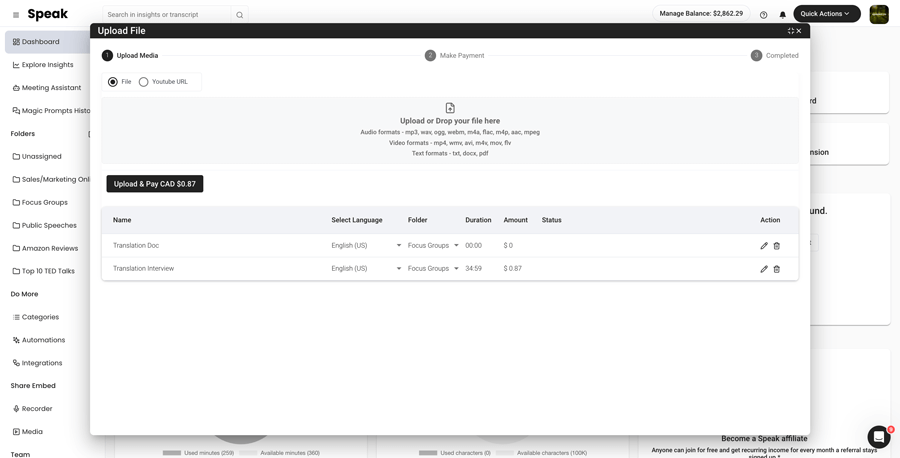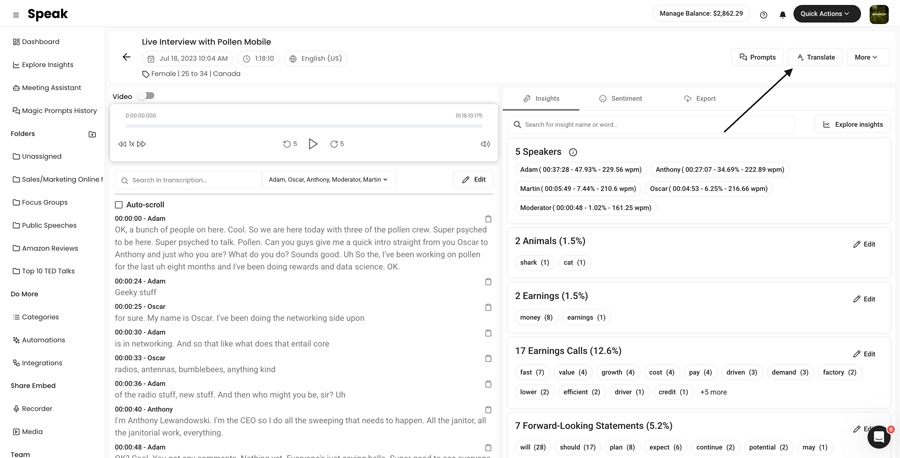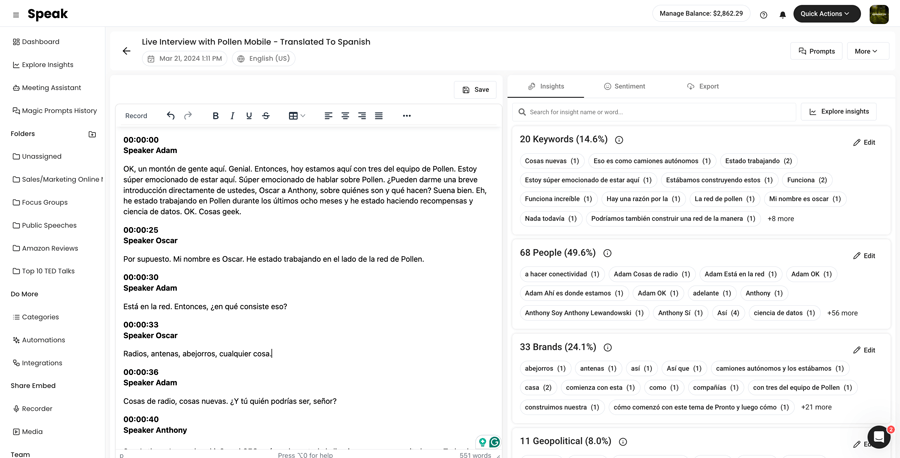How To Translate Japanese to Sinhala (Sinhalese)
Translating Japanese to Sinhala (Sinhalese) is super simple!

Step 1: Register for Speak
Register for Speak using this link.
Once you register, you can instantly begin translating your Japanese to Sinhala (Sinhalese) file(s).

Step 2: Upload Your Japanese file(s)
As soon as you log in, you will be redirected to the dashboard.
Once there, you can select the Quick Action "New Upload".
In Speak, you can seamlessly upload, transcribe and translate audio, video and text files all at once!

Step 3: Translate Your Japanese file(s) to Sinhala (Sinhalese)
Once the file is uploaded, simply visit your file and select "Translate".
If it is an audio and video file, Speak will ask you if you want to keep the speaker names and timestamps in the translation.
Want to translate many files at once? No problem!
You can view the files you want to automatically translate from Japanese to Sinhala (Sinhalese) from the folder level and instantly translate as many files as you need with our artificial intelligence translation in just a few clicks.

Step 4: That's It! View, Analyze, Modify & Export Your New Sinhala (Sinhalese) file(s)
Once the translation is done, you will be alerted and you will see a new document in the same folder your original file is in.
The file will be named the same but with a dash indicating that it is the translated version.
Need support with your Japanese translation?
We are always here and happy to help at Speak!
Just send us a message on live chat on the bottom right corner and we will ensure you are set up for success.
Interested in translating Japanese or other languages to different languages? View our entire list of supported translation languages here.
Automatic, accurate, instant AI translation from Japanese to Sinhala (Sinhalese) is here for you.
Register for Speak using this link and begin translating Japanese to Sinhala (Sinhalese) today.
Unlock the Power of Language: The Essential Guide to Japanese to Sinhala (Sinhalese) Translation
In a world that's more connected than ever, the ability to communicate across cultural and language barriers is invaluable. For businesses, researchers, and individuals who engage with both Japanese and Sinhalese-speaking communities, translating content between these two languages can open up new opportunities, foster stronger relationships, and drive innovation. Speak AI, leveraging the best of AI translation, is at the forefront of making these connections easier, faster, and more efficient.
The Rising Importance of Japanese and Sinhala (Sinhalese) Translations
As global business operations and academic collaborations continue to expand, the demand for high-quality, accurate translation services grows. Japanese and Sinhala (Sinhalese), as languages of countries with unique cultures and strong economic ties, are increasingly important in the spheres of trade, tourism, technology, and education. Speak AI's translation technology empowers users to bridge the language gap with ease, whether it's for drafting contracts, creating bilingual content, or facilitating clear communication in meetings.
Transform Your Content: From Japanese to Sinhala (Sinhalese) and Beyond
The capabilities of Speak AI's translation technology extend far beyond basic text translations. Imagine automatically converting audio and video content, analyzing the sentiment and context in real-time, and interacting with a global audience without language barriers. This is the reality that Speak AI's tools—including our acclaimed AI Meeting Assistant—provide for businesses and researchers worldwide.
Automatic Translation: A Leap Towards Efficiency
Speak AI harnesses advanced NLP, large language models, and generative AI to offer seamless Japanese to Sinhala (Sinhalese) translation. This automation translates to significant time and cost savings, reducing the need for manual translation work while increasing accuracy and speed. Whether it's live translation during video calls or automatic transcription of recorded content, Speak AI delivers unparalleled convenience and reliability.
Benefits: Bridging Languages, Connecting Worlds
- Increased Accessibility: Make your content, products, and services accessible to a broader audience, enhancing user experience and satisfaction.
- Cultural Sensitivity: With nuanced and context-aware translation, Speak AI ensures that your message respects cultural differences, enhancing your brand's image and trustworthiness.
- Enhanced Collaboration: Facilitate smooth communication in international teams and projects, fostering innovation and creativity across language divides.
- Insightful Analysis: Beyond translation, gain insights into customer sentiment, trends, and more with Speak AI's advanced analytics capabilities.
Demystifying the Languages: Japanese and Sinhala (Sinhalese) at a Glance
Understanding the significance of Japanese and Sinhala (Sinhalese) not only emphasizes the importance of translation services but also enriches our appreciation of these rich linguistic traditions.
Global Presence and Cultural Impact
Japanese is the language of over 128 million speakers, predominantly in Japan but also across the globe, from Brazil to the United States. Sinhala, spoken by about 17 million people, is the majority language of Sri Lanka, with a diaspora present in countries like the UAE, the UK, and Canada. The interaction between these languages and cultures is a testament to our interconnected world.
Unique Linguistic Features and Fun Facts
Japanese and Sinhala (Sinhalese) both boast unique scripts and linguistic structures that reflect their cultural richness. Japanese uses a combination of Kanji, Hiragana, and Katakana, while Sinhala features a script with distinctive round shapes, owing to its Brahmi script origins. A fun fact is that Japanese has a rich system of honorifics, indicating respect or social status, whereas Sinhala utilizes specific formality levels in verbs to convey respect.
Understanding Through Translation: Similarities and Differences
Despite their distinct origins—Japanese belonging to the Japonic family and Sinhala being an Indo-Aryan language—both languages value politeness and context in communication. However, their grammatical structures, phonetics, and writing systems present unique challenges in translation, making advanced AI technologies like Speak AI’s essential for accurate and contextually nuanced translations.
Empower Your Communication with Speak AI
In today's global village, the ability to speak and understand multiple languages is more than a skill—it's a necessity. With Speak AI's advanced translation technology, businesses and researchers can effortlessly translate Japanese to Sinhala (Sinhalese), ensuring their message resonates with every audience. Embrace the future of communication and join over 150K users who have elevated their global reach with Speak AI, rated 4.9 on G2 for its groundbreaking technology.
FAQ: Japanese and Sinhala (Sinhalese)
What locations are Japanese and Sinhala (Sinhalese) popular?
Japanese is widely spoken in Japan, with significant communities in Brazil, the United States, and parts of Europe. Sinhala is predominantly spoken in Sri Lanka, with speakers also in the United Arab Emirates, the United Kingdom, Canada, and Australia. These languages mark the identity of vibrant communities with rich histories and traditions.
What are some fun facts about Japanese and Sinhala (Sinhalese)?
Japanese features three different writing systems (Kanji, Hiragana, and Katakana), each serving distinct roles in the language. Sinhala (Sinhalese) is known for its circular script, which is unique among the world’s alphabets and reflects its rich literary tradition.
What are the differences and similarities between Japanese and Sinhala (Sinhalese)?
Both languages place a high value on politeness and social context in communication. However, they belong to different language families, which influences their syntax, phonology, and script. Japanese uses a subject-object-verb (SOV) order, whereas Sinhala syntax is more flexible, often following a subject-verb-object (SVO) order similar to English.
Embrace the power of language with Speak AI and unlock new opportunities in communication and collaboration across cultures.
Translate Japanese To These Other Supported Languages:
- Translate Japanese-to-Afrikaans
- Translate Japanese-to-Albanian
- Translate Japanese-to-Amharic
- Translate Japanese-to-Arabic (Egypt)
- Translate Japanese-to-Arabic (Iraq)
- Translate Japanese-to-Arabic (Israel)
- Translate Japanese-to-Arabic (Jordan)
- Translate Japanese-to-Arabic (Kuwait)
- Translate Japanese-to-Arabic (Lebanon)
- Translate Japanese-to-Arabic (Oman)
- Translate Japanese-to-Arabic (Palestinian Authority)
- Translate Japanese-to-Arabic (Qatar)
- Translate Japanese-to-Arabic (Saudi Arabia)
- Translate Japanese-to-Arabic (Syrian Arab Republic)
- Translate Japanese-to-Arabic (United Arab Emirates)
- Translate Japanese-to-Arabic Modern Standard (Bahrain)
- Translate Japanese-to-Armenian
- Translate Japanese-to-Assamese
- Translate Japanese-to-Aymara
- Translate Japanese-to-Azerbaijani
- Translate Japanese-to-Bambara
- Translate Japanese-to-Basque
- Translate Japanese-to-Belarusian
- Translate Japanese-to-Bengali
- Translate Japanese-to-Bhojpuri
- Translate Japanese-to-Bosnian
- Translate Japanese-to-Bulgarian
- Translate Japanese-to-Catalan
- Translate Japanese-to-Cebuano
- Translate Japanese-to-Chinese (Simplified)
- Translate Japanese-to-Chinese (Traditional)
- Translate Japanese-to-Corsican
- Translate Japanese-to-Croatian
- Translate Japanese-to-Czech
- Translate Japanese-to-Danish
- Translate Japanese-to-Dari
- Translate Japanese-to-Dhivehi
- Translate Japanese-to-Dogri
- Translate Japanese-to-Dutch
- Translate Japanese-to-English
- Translate Japanese-to-English (Australia)
- Translate Japanese-to-English (Indian)
- Translate Japanese-to-English (Irish)
- Translate Japanese-to-English (New Zealand)
- Translate Japanese-to-English (Scottish)
- Translate Japanese-to-English (South African)
- Translate Japanese-to-English (United Kingdom)
- Translate Japanese-to-English (United States)
- Translate Japanese-to-Esperanto
- Translate Japanese-to-Estonian
- Translate Japanese-to-Ewe
- Translate Japanese-to-Farsi (Persian)
- Translate Japanese-to-Filipino Tagalog
- Translate Japanese-to-Finnish
- Translate Japanese-to-French
- Translate Japanese-to-French (Canada)
- Translate Japanese-to-Frisian
- Translate Japanese-to-Galician
- Translate Japanese-to-Georgian
- Translate Japanese-to-German
- Translate Japanese-to-German (Swiss)
- Translate Japanese-to-Greek
- Translate Japanese-to-Guarani
- Translate Japanese-to-Gujarati
- Translate Japanese-to-Haitian Creole
- Translate Japanese-to-Hausa
- Translate Japanese-to-Hawaiian
- Translate Japanese-to-Hebrew
- Translate Japanese-to-Hindi
- Translate Japanese-to-Hmong
- Translate Japanese-to-Hungarian
- Translate Japanese-to-Icelandic
- Translate Japanese-to-Igbo
- Translate Japanese-to-Ilocano
- Translate Japanese-to-Indonesian
- Translate Japanese-to-Irish
- Translate Japanese-to-Italian
- Translate Japanese-to-Japanese
- Translate Japanese-to-Javanese
- Translate Japanese-to-Kannada
- Translate Japanese-to-Kazakh
- Translate Japanese-to-Khmer
- Translate Japanese-to-Kinyarwanda
- Translate Japanese-to-Konkani
- Translate Japanese-to-Korean
- Translate Japanese-to-Krio
- Translate Japanese-to-Kurdish
- Translate Japanese-to-Kurdish (Sorani)
- Translate Japanese-to-Kyrgyz
- Translate Japanese-to-Lao
- Translate Japanese-to-Latin
- Translate Japanese-to-Latvian
- Translate Japanese-to-Lingala
- Translate Japanese-to-Lithuanian
- Translate Japanese-to-Luganda
- Translate Japanese-to-Luxembourgish
- Translate Japanese-to-Macedonian
- Translate Japanese-to-Maithili
- Translate Japanese-to-Malagasy
- Translate Japanese-to-Malay
- Translate Japanese-to-Malayalam
- Translate Japanese-to-Maltese
- Translate Japanese-to-Maori
- Translate Japanese-to-Marathi
- Translate Japanese-to-Meiteilon (Manipuri)
- Translate Japanese-to-Mizo
- Translate Japanese-to-Mongolian
- Translate Japanese-to-Myanmar (Burmese)
- Translate Japanese-to-Nepali
- Translate Japanese-to-Norwegian
- Translate Japanese-to-Nyanja (Chichewa)
- Translate Japanese-to-Odia (Oriya)
- Translate Japanese-to-Oromo
- Translate Japanese-to-Pashto
- Translate Japanese-to-Persian
- Translate Japanese-to-Polish
- Translate Japanese-to-Portuguese
- Translate Japanese-to-Portuguese (Brazilian)
- Translate Japanese-to-Portuguese (Portugal)
- Translate Japanese-to-Punjabi
- Translate Japanese-to-Quechua
- Translate Japanese-to-Romanian
- Translate Japanese-to-Russian
- Translate Japanese-to-Samoan
- Translate Japanese-to-Sanskrit
- Translate Japanese-to-Scots Gaelic
- Translate Japanese-to-Sepedi
- Translate Japanese-to-Serbian
- Translate Japanese-to-Sesotho
- Translate Japanese-to-Shona
- Translate Japanese-to-Sindhi
- Translate Japanese-to-Sinhala
- Translate Japanese-to-Sinhala (Sinhalese)
- Translate Japanese-to-Slovak
- Translate Japanese-to-Slovenian
- Translate Japanese-to-Somali
- Translate Japanese-to-Spanish
- Translate Japanese-to-Spanish (Mexico)
- Translate Japanese-to-Sundanese
- Translate Japanese-to-Swahili
- Translate Japanese-to-Swedish
- Translate Japanese-to-Tajik
- Translate Japanese-to-Tamil
- Translate Japanese-to-Tatar
- Translate Japanese-to-Telugu
- Translate Japanese-to-Thai
- Translate Japanese-to-Tigrinya
- Translate Japanese-to-Tsonga
- Translate Japanese-to-Turkish
- Translate Japanese-to-Turkmen
- Translate Japanese-to-Twi (Akan)
- Translate Japanese-to-Ukrainian
- Translate Japanese-to-Urdu
- Translate Japanese-to-Uyghur
- Translate Japanese-to-Uzbek
- Translate Japanese-to-Vietnamese
- Translate Japanese-to-Welsh
- Translate Japanese-to-Xhosa
- Translate Japanese-to-Yiddish
- Translate Japanese-to-Yoruba
- Translate Japanese-to-Zulu



